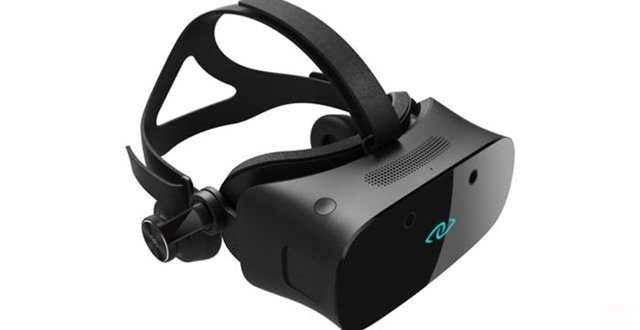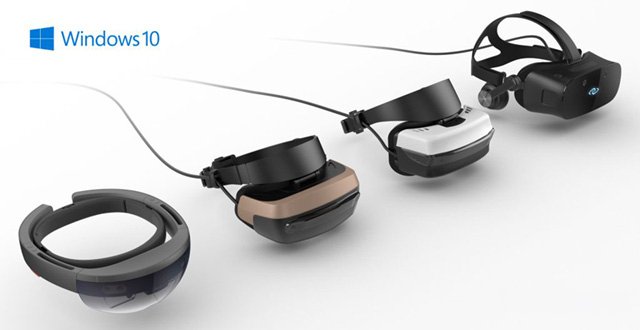Microsoft will ship the first connected VR headset for Windows 10 PC to developers at the Game Developers Conference (GDC) in March this year. The GDC Conference will be held in San Francisco, USA, from February 27th to March 3rd.
Microsoft's first Windows 10 VR Headset will be a component for developers to write and test applications based on the Windows Holographic platform. Vlad Kolesnikov, Microsoft's senior project director, said on Friday that the head is compatible with the Windows 10 Creators Update.

Branded Windows 10 VR Headset
Microsoft has no plans to introduce the consumer version of Windows 10 VR heads. However, in the second half of this year, you will experience 3Glasses, Lenovo, ASUS, Acer, HP and Dell to experience the brand's Windows 10 VR head-mounted display.
This head-mounted display works like HoloLens, allowing users to interact with 3D objects that are superimposed on the real world. Like the Oculus Rift, users can also use the headset to watch movies, open other applications, or play games in 3D. These heads need to be connected to the PC and let the computer provide it with computing horsepower. This is different from HoloLens, which is an integrated head display and can perform all its calculations on its own.
Kolesnikov also stated that Microsoft will provide updates to the VR development API on Windows Developer Day, which will be held on February 8.
VR has very high requirements for PCs, and Microsoft has also set the minimum hardware specifications for this head. The notebook needs at least an Intel Core i5 chip based on the Kaby Lake architecture and 8GB of dual channel memory; the desktop PC needs an Intel Core i5 chip based on Skylake. Gamers use faster GPUs, CPUs, and memory. In addition, the first display will also support AMD's CPU and GPU, but Microsoft has not provided specific specifications.

When the user inserts the Windows 10 PC, the system will automatically detect the head display and the driver will be automatically installed. The next step the user needs to perform is to set the "play area." The head display scans and measures the room and warns you when the user steps out of the play area. The built-in camera takes pictures of the surrounding environment and creates a mapping model, which also has tracking technology for tracking user movements.
Headset supports Cortana Xiaona so that the user can make voice commands or interact with the content via voice. Currently Microsoft's products support 9 kinds of speech, and more language support will be added during the holiday season this year.
All Windows 10 applications (such as Skype) will support this display. Beginning with Creators Update, Microsoft will launch the “Movie and TV app†and provide users with a series of 360-degree videos that can be viewed through the VR headset. Edge browser will also support VR content through the WebVR standard. In addition, Microsoft will also introduce some of its HoloLens applications to VR head displays.
brightness
LCD is a substance between solid and liquid. It can't emit light by itself, so it needs additional light source. Therefore, the number of lamps is related to the brightness of the Liquid Crystal Display. The earliest liquid crystal displays had only two upper and lower tubes, the lowest of the popular type was four lamps, and the high-end one was six lamps. The four-lamp design is divided into three types of placement: one is that there is a lamp on each of the four sides, but the disadvantage is that there will be dark shadows in the middle. The solution is to arrange the four lamps from top to bottom. The last one is the "U"-shaped placement form, which is actually two lamp tubes produced by two lamps in disguise. The six-lamp design actually uses three lamps. The manufacturer bends all three lamps into a "U" shape, and then places them in parallel to achieve the effect of six lamps.
Tip: Brightness is also a more important indicator. The brighter the LCD, the brighter the LCD, it will stand out from a row of LCD walls. The highlight technology we often see in CRT (ViewSonic is called highlight, Philips is called display Bright, BenQ is called Rui Cai) is to increase the current of the shadow mask tube to bombard the phosphor to produce a brighter effect. Such a technology is generally traded at the expense of image quality and the life of the display. All use this The products of this kind of technology are all bright in the default state, you always have to press a button to implement, press 3X bright to play the game; press again to turn to 5X bright to watch the video disc, a closer look is blurred, you need to watch The text has to be honestly returned to the normal text mode. This design actually prevents you from frequently highlighting. The principle of LCD display brightness is different from that of CRT. They are realized by the brightness of the backlight tube behind the panel. Therefore, the lamp has to be designed more so that the light will be uniform. In the early days when selling LCDs, it was a great thing to tell others that there were three LCDs. But at that time, Chi Mei CRV came up with a six-lamp technology. In fact, the three tubes were bent into a "U" shape. The so-called six; such a six-lamp design, plus the strong luminescence of the lamp itself, the panel is very bright, such a representative work is represented by VA712 in ViewSonic; but all bright panels will have a fatal injury , The screen will leak light, this term is rarely mentioned by ordinary people, the editor personally thinks it is very important, light leakage means that under a completely black screen, the liquid crystal is not black, but whitish and gray. Therefore, a good LCD should not emphasize brightness blindly, but more emphasis on contrast. ViewSonic's VP and VG series are products that do not emphasize brightness but contrast!
Lcd Display,LCD Screen,Lcd Tft Display Screen,4 Inch Mipi Lcd Screen,Square Tft Lcd Display
ESEN Optoelectronics Technology Co., Ltd, , https://www.esenlcd.com